
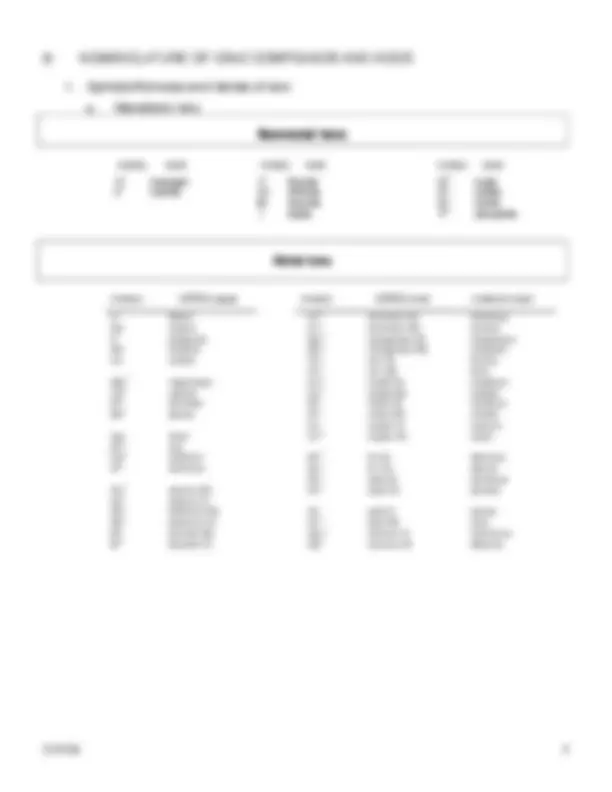
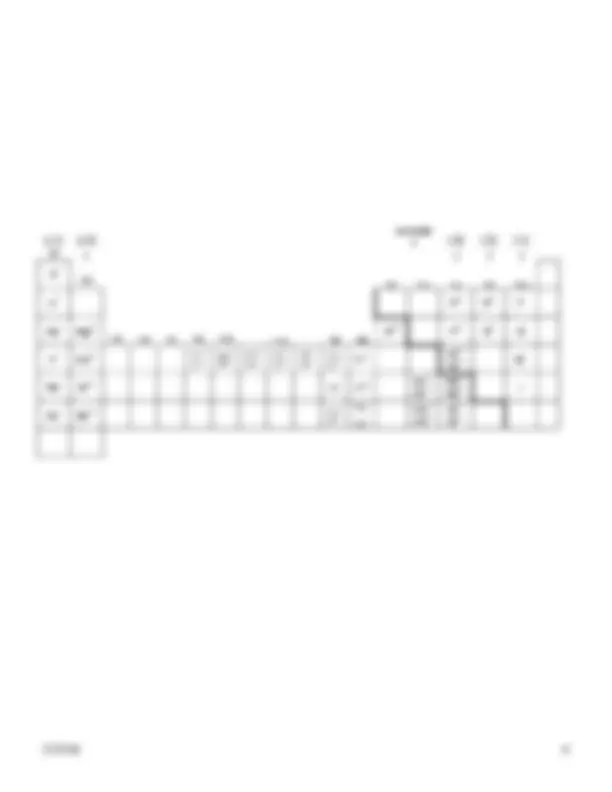
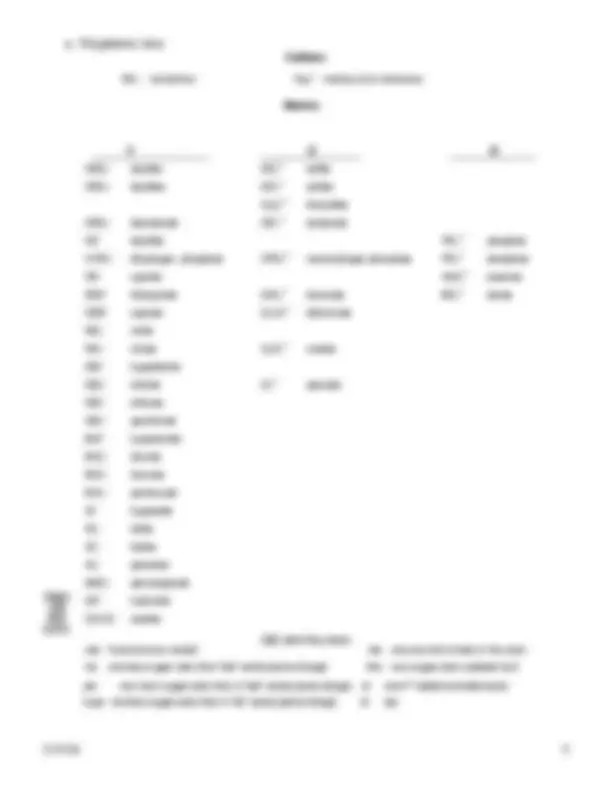
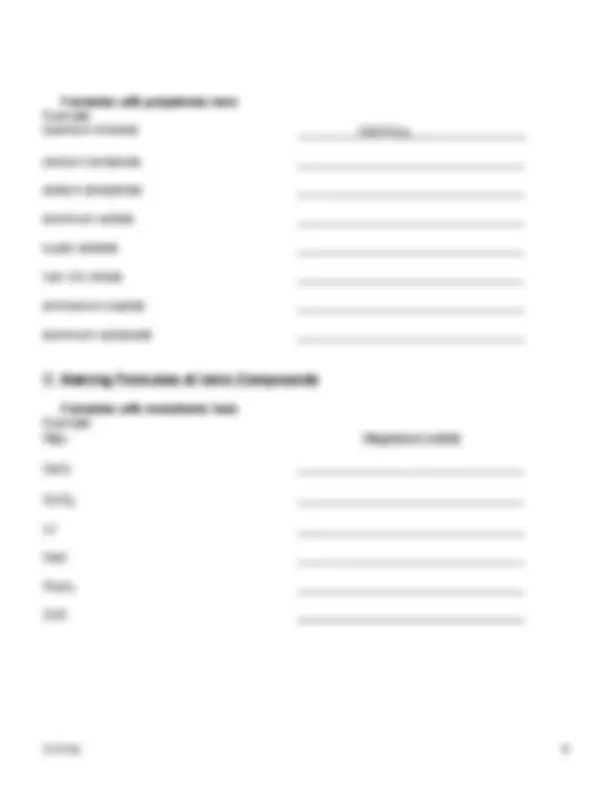
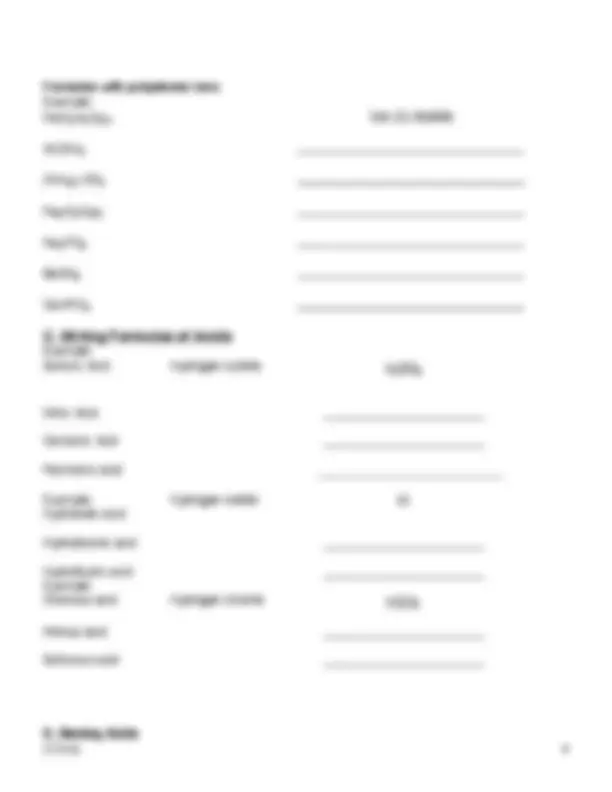
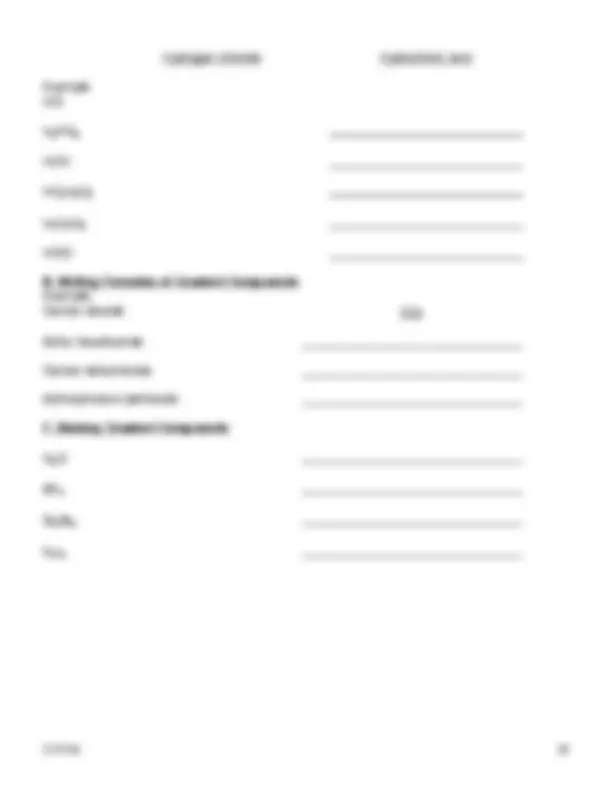


Study with the several resources on Docsity

Earn points by helping other students or get them with a premium plan


Prepare for your exams
Study with the several resources on Docsity

Earn points to download
Earn points by helping other students or get them with a premium plan
Community
Ask the community for help and clear up your study doubts
Discover the best universities in your country according to Docsity users
Free resources
Download our free guides on studying techniques, anxiety management strategies, and thesis advice from Docsity tutors
In this experiment you will: Write the chemical formulas of given named compounds. Write the names of given compound formulas. Page 2 ...
Typology: Study notes
1 / 12

This page cannot be seen from the preview
Don't miss anything!







PURPOSE: The purpose of this lab is to write the names and formulas of chemical compounds so that eventually the students will be able to write complete balanced chemical equations. I. INTRODUCTION So far you have learned what a chemical symbol is. For example, Pb is the symbol for the element lead. Elements are not often found pure in nature. Most elements are chemically combined in a definite ratio with other elements. These types of substances are called compounds. Most of the earth’s hydrogen is not in the form H 2 , but is in water in the form H 2 O. Just as elements have symbols, compounds have formulas. It is very important that a chemistry student learn how to name formulas and learn to write the correct formula from a given name. The elements in a compound are in a definite or set ratio. Water is always H 2 O, never anything else. The ratio is always 2 hydrogens to 1 oxygen. This definite composition is what makes compounds unique from mixtures. In experiment 5 you learned that a mixture of two substances can be in any ratio or proportion. Chemistry is largely about describing chemical reactions and predicting their results. In order to correctly write a chemical equation we must first learn how to write and name chemical formulas. For example, we may be given a reaction in sentence form: When aqueous silver nitrate reacts with aqueous sodium chloride a precipitate silver chloride is formed and the sodium and nitrate ions remain in solution. It is impractical to leave the reaction in sentence form. Chemists have a short hand version that looks like this:
Before we can successfully write a chemical equation, we must first learn how to write formulas from the names of compounds and how to name formulas. In this experiment you will: Write the chemical formulas of given named compounds Write the names of given compound formulas
(+1) (+2) nonmetal s (-3)^ (-2)^ (-1) IA (^) ↓ ↓ ↓ ↓ H+ IIA (^) IIIA IVA VA VIA VIIA Li+^ N^3 -^ O^2 -^ F- Na+^ Mg2+ IIIB (^) IVB VB VIB VIIB (^) VIIIB IB IIB Al3+^ P^3 -^ S^2 -^ Cl- K+^ Ca2+^ Cr2+ Cr3+ Mn2+ Mn3+ Fe2+ Fe3+ Co2+ Co3+ Ni2+ Ni3+ Cu+ Cu2+^ Zn 2+ As 3+ As5+^ Br- Rb+^ Sr2+^ Ag+^ Cd2+^ Sn2+ Sn4+ Sb3+ Sb5+^ I- Cs+^ Ba2+^ Au
Au3+ Hg + 22 Hg2+ Pb2+ Pb4+ Bi3+ Bi5+
b. Polyatomic Ions Cations NH 4 +^ ammonium Hg 2 2+^ mercury (I) or mercurous Anions PREFI XES AND SUFFI XES (what they mean)
HSO 3 –^ bisulfite SO 32 –^ sulfite HSO 4 –^ bisulfate SO 42 –^ sulfate S 2 O 32 –^ thiosulfate HCO 3 –^ bicarbonate CO 32 –^ carbonate HS–^ bisulfide PO 33 –^ phosphite H 2 PO 4 –^ dihydrogen phosphate HPO 42 –^ monohydrogen phosphate PO 43 –^ phosphate CN–^ cyanide AsO 43 -^ arsenate SCN–^ thiocyanate CrO 42 –^ chromate BO 33 –^ borate OCN–^ cyanate Cr 2 O 72 –^ dichromate NO 2 –^ nitrite NO 3 –^ nitrate C 2 O 42 –^ oxalate ClO–^ hypochlorite ClO 2 –^ chlorite O 22 –^ peroxide ClO 3 –^ chlorate ClO 4 –^ perchlorate BrO–^ hypobromite BrO 2 –^ bromite BrO 3 –^ bromate BrO 4 –^ perbromate IO–^ hypoiodite IO 2 –^ iodite IO 3 –^ iodate IO 4 –^ periodate MnO 4 –^ permanganate OH–^ hydroxide C 2 H 3 O 2 –^ acetate
II. Procedure A Writing Formulas of Ionic Compounds Formulas with two monatomic ions in which there is only one form of the metal ion: Example: barium oxide ____________BaO__________________ potassium chloride __________________________________ aluminum bromide __________________________________ calcium oxide __________________________________ strontium nitride __________________________________ aluminum oxide __________________________________ cadmium phosphide __________________________________ silver fluoride __________________________________ Formulas with two monatomic ions in which there is more than one form of the metal ion Example: cuprous fluoride (^) _________________CuF 2 _____________ ferric chloride __________________________________ copper (I) sulfide __________________________________ nickel (II) oxide __________________________________ iron (II) bromide __________________________________ stannic oxide __________________________________ plumbic iodide __________________________________ lead (II) sulfide __________________________________ gold (III) oxide __________________________________
Formulas with polyatomic ions Example: cadmium chlorate (^) _________Cd(ClO 3 ) 2 _________________ calcium carbonate __________________________________ sodium phosphate __________________________________ aluminum sulfate __________________________________ cupric acetate __________________________________ Iron (III) nitrate __________________________________ ammonium oxalate __________________________________ aluminum carbonate __________________________________ B. Naming Formulas of Ionic Compounds Formulas with monatomic Ions Example: MgI 2 Magnesium iodide CaF 2 __________________________________ CuCl 2 __________________________________ LiI __________________________________ FeO __________________________________ Pb 3 N 4 __________________________________ ZnS __________________________________
Example HCl Hydrogen chloride Hydrochloric acid H 3 PO 4 _____________________________ HCN _____________________________ HC 2 H 3 O 2 _____________________________ H 2 C 2 O 4 _____________________________ HClO _____________________________ E. Writing Formulas of Covalent Compounds Example: Carbon dioxide (^) CO 2 Sulfur hexafluoride _________________________________ Carbon tetrachloride _________________________________ diphosphoours pentoxide _________________________________ F. Naming Covalent Compounds N 2 O _________________________________ BF 3 _________________________________ Si 2 Br 6 _________________________________ P 2 I 4 _________________________________
Name ______________________________ Date ______________ Lab Section __________ Initials________ EXPERIMENT 6 WRITING AND NAMING CHEMICAL FORMULAS For each of the following indicate the type of compound using “A” for acid, “I” for ionic or “C” for covalent. Write the formulas of the following compounds. Write the names of the following compounds. Sodium nitrite __________________ CaBr 2 _ _________________ Aluminum bisulfite __________________ PbS 2 O 3 _ _________________ Nitrous acid __________________ Cd(NO 3 ) 2 _ _________________ Ferrous Oxide __________________ Cu(ClO 3 ) 2 _ _________________ Silver oxalate __________________ PbCr 2 O 7 _ _________________ Iodic acid __________________ P 2 O 5 __________________ Chlorine monobromide __________________ Al(ClO 3 ) 3 _ _________________ Stannous phosphate __________________ Na 3 N __________________ Hydrocyanic acid __________________ Sb 2 (SO 3 ) 5 _ _________________ Copper (II) hydroxide __________________ Hg 2 (ClO) 2 _ _________________ Sulfurous acid __________________ Mg(OH) 2 _ _________________ Sulfuric acid __________________ P 2 O 5 _ _________________ Phosphorous acid __________________ NH 4 Cl __________________ Periodic acid __________________ FeCl 3 _ _________________ Dichlorine monoxide __________________ FeCl 2 _ _________________ Sulfur hexafluoride __________________ HF __________________ Ammonium phosphite __________________ CdI 2 _ _________________